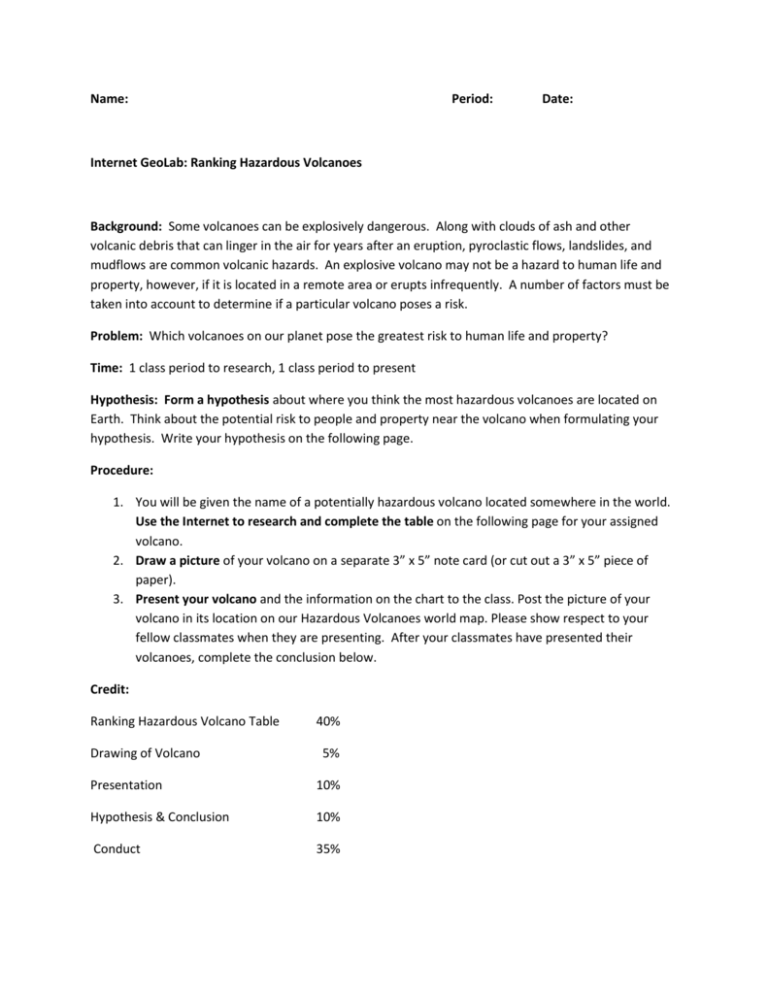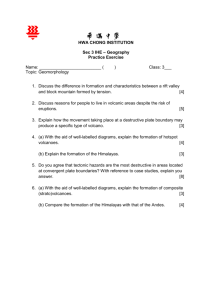ranking hazardous volcanoes_internet lab
advertisement

Name: Period: Date: Internet GeoLab: Ranking Hazardous Volcanoes Background: Some volcanoes can be explosively dangerous. Along with clouds of ash and other volcanic debris that can linger in the air for years after an eruption, pyroclastic flows, landslides, and mudflows are common volcanic hazards. An explosive volcano may not be a hazard to human life and property, however, if it is located in a remote area or erupts infrequently. A number of factors must be taken into account to determine if a particular volcano poses a risk. Problem: Which volcanoes on our planet pose the greatest risk to human life and property? Time: 1 class period to research, 1 class period to present Hypothesis: Form a hypothesis about where you think the most hazardous volcanoes are located on Earth. Think about the potential risk to people and property near the volcano when formulating your hypothesis. Write your hypothesis on the following page. Procedure: 1. You will be given the name of a potentially hazardous volcano located somewhere in the world. Use the Internet to research and complete the table on the following page for your assigned volcano. 2. Draw a picture of your volcano on a separate 3” x 5” note card (or cut out a 3” x 5” piece of paper). 3. Present your volcano and the information on the chart to the class. Post the picture of your volcano in its location on our Hazardous Volcanoes world map. Please show respect to your fellow classmates when they are presenting. After your classmates have presented their volcanoes, complete the conclusion below. Credit: Ranking Hazardous Volcano Table Drawing of Volcano 40% 5% Presentation 10% Hypothesis & Conclusion 10% Conduct 35% Name: Period: Date: Hypothesis: My hypothesis is that most hazardous volcanoes are located: __________________________________________________________________________________. Table: Hazardous Volcano Ranking Volcano name Country (and state, if in U.S.) Location of volcano (Latitude and Longitude) Type of Volcano (shield, cinder-cone, composite) Composition of lava Explosiveness Date of last eruption Eruption interval (number of eruptions over a period of time) Height of volcano Distance to nearest population center Approximate number of people living near the volcano Type(s) of potential hazards Assign a human hazard ranking (high, medium, low) Conclusion: In your opinion, which volcano presented threatens the greatest number of people? Why? Where are most of the hazardous volcanoes in the world located? Sample Hazardous Volcano Ranking Table Volcano name Country (and state, if in U.S.) Location of volcano (Latitude and Longitude) Type of Volcano Composition of lava/Explosiveness Date of last eruption Eruption interval (number of eruptions over a period of time) Height of volcano Distance to nearest population center Approximate number of people living near the volcano Type(s) of potential hazards Human hazard ranking (high, medium, low) El Chichon Mexico 17.4°N, 93.2°W It is a composite volcano. The volcano is made of andesite. This volcano is highly explosive. 1982 Unknown 1060 m Multiple small villages are located on the volcano itself. The nearby population is estimated to be between 10,000 and 20,000 people. The types of hazards include pyroclastic flows, ash falls, and mudflows. The human hazard ranking is medium because of the long eruption interval. Resource Sites: Volcano World http://volcano.und.edu/ Volcano World contains images and information about past and current volcanic eruptions. The data are searchable by country, world region, name, or description of a volcano. The fact that the data are searchable by country makes this link a good place to start the activity. Note: Students should consult a traditional reference source to determine the approximate number of people living near a volcano of interest. Atlases and encyclopedias should be used for population estimates. Smithsonian Institution - Global Volcanism Program http://www.volcano.si.edu/ The global volcanism program of the national museum of natural history and the Smithsonian institution also provides data for volcanoes of the world, searchable by volcano name or geographic region. Like volcano world, volcano data include elevation, latitude/longitude, and type of volcano. U.S. Geological Survey Volcano Hazards Program http://volcanoes.usgs.gov/ This web page includes background information on volcanic hazards, including types of hazards, volcano monitoring, and emergency planning and warning. Volcanic Hazards, Features, and Phenomena http://vulcan.wr.usgs.gov/Glossary/framework.html This site provides an exhaustive list (and definitions) of terms related to volcanic features and hazards. It is a good reference for terminology as you search for data on a particular volcano. Michigan Technological University Volcanoes Page http://www.geo.mtu.edu/volcanoes/ This page provides background information in volcanology. It contains several interesting links that discuss types of volcanic hazards and hazard mitigation for volcanic regions of high population density.





